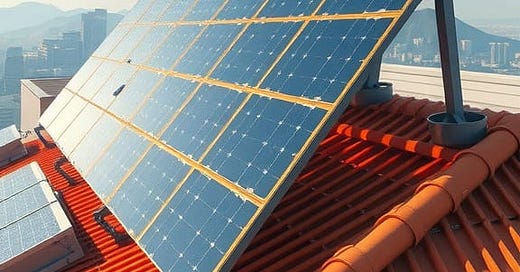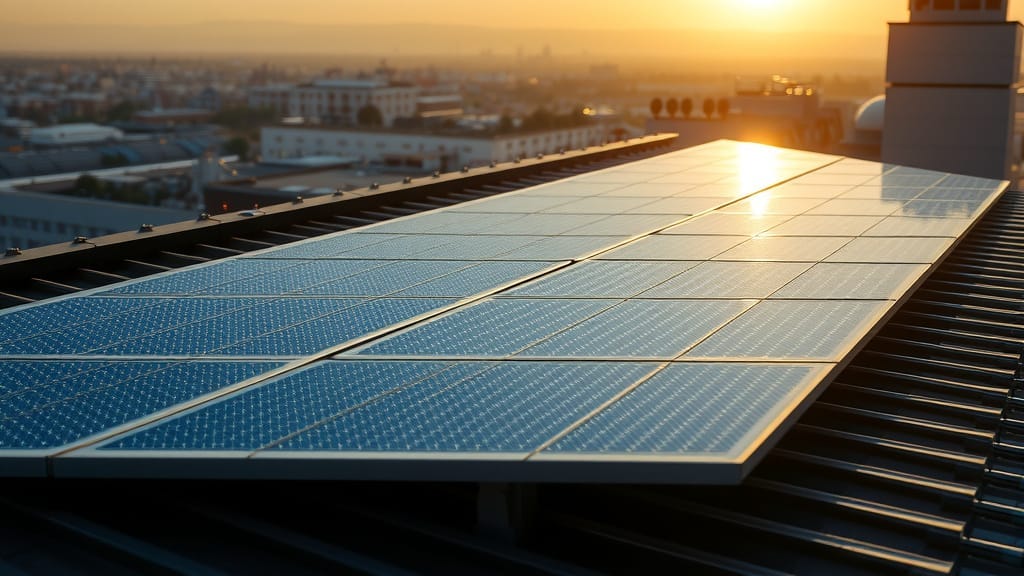Thin-Film Solar Panels: A Deeper Look into the Future of Solar Power
And We Want to Hear From You!
The world of solar energy is constantly evolving, with innovations emerging that promise to make clean power more accessible, versatile, and efficient. While traditional crystalline silicon panels have long been the industry standard, a fascinating alternative has been steadily gaining ground: thin-film solar technology.
In this in-depth article, we'll delve into the intricacies of thin-film solar panels, dissecting their unique characteristics, examining their distinct advantages and disadvantages, and looking at where they fit into the broader solar landscape. But crucially, we also want to open the floor to you, our readers, to share your real-world experiences and recommendations.
What Exactly Are Thin-Film Solar Panels?
Unlike the rigid, wafer-based crystalline silicon panels most people picture, thin-film solar panels are characterised by their incredibly slender construction. As their name suggests, they are manufactured by depositing one or more layers of photovoltaic (PV) material – often just a few micrometres thick – onto a substrate such as glass, plastic, or metal. This innovative manufacturing process allows for panels that are significantly lighter, more flexible, and can even be transparent or semi-transparent.
The primary types of thin-film solar cells you'll encounter include:
Amorphous Silicon (a-Si): This is the oldest and most mature thin-film technology, using non-crystalline silicon. It's known for its flexibility and lower manufacturing costs.
Cadmium Telluride (CdTe): A popular choice, especially for utility-scale solar farms, due to its high absorption coefficient and relatively cost-effective production.
Copper Indium Gallium Selenide (CIGS): These panels offer high efficiency among thin-film options and can be deposited on flexible substrates, making them versatile for various applications.
Gallium Arsenide (GaAs): While extremely efficient, GaAs cells are very expensive to produce and are typically reserved for specialised applications like spacecraft and satellites.
The fundamental principle remains the same as any other solar panel: converting sunlight into electricity through the photovoltaic effect. However, the thin layers and different material compositions of thin-film panels result in distinct performance characteristics and ideal use cases.
The Clear Advantages of Thin-Film Solar Technology
Thin-film solar panels bring a compelling set of benefits to the table, making them a strong contender for specific applications:
Flexibility and Lightweight Design: This is arguably their most significant advantage. Their ultra-thin nature means they can be made flexible, allowing them to conform to curved surfaces, be integrated into building materials (Building-Integrated Photovoltaics or BIPV), or used in portable applications like RVs, boats, or even wearable tech. Their low weight also reduces structural requirements for installation.
Aesthetic Integration: For those prioritising seamless aesthetics, thin-film panels can be a game-changer. They can blend more discreetly into architectural designs, appearing less obtrusive than their crystalline counterparts. Transparent or semi-transparent options open up possibilities for solar-generating windows or skylights.
Better Performance in Low-Light and High-Temperature Conditions: While their peak efficiency might be lower (more on that below), thin-film panels often exhibit a better "temperature coefficient" and can perform more effectively in less-than-ideal conditions, such as cloudy days, shaded areas, or extremely hot climates. This means less degradation in power output as temperatures rise above optimal levels.
Lower Material Consumption and Manufacturing Costs: The production of thin-film panels generally requires less semiconductor material compared to crystalline silicon. This can lead to lower manufacturing costs and a potentially smaller environmental footprint in terms of raw material extraction and energy-intensive processing.
Ease of Installation: In many cases, particularly with flexible variants, thin-film panels can be installed with adhesives, reducing the need for heavy racking systems and making the installation process quicker and less labour-intensive.
The Important Considerations: Weighing the Disadvantages
While the advantages are appealing, it's crucial to understand the limitations of thin-film solar technology, especially when considering them for residential or typical commercial rooftop installations:
Lower Efficiency: This is the most significant drawback. Currently, commercially available thin-film panels have a lower energy conversion efficiency (typically 7-13%) compared to mainstream crystalline silicon panels (18-24% or higher). This means you'll need a larger surface area to generate the same amount of electricity. For homes with limited roof space, this can be a major constraint.
More Space Required: Directly linked to lower efficiency, if you need a specific amount of power, you'll need to install more thin-film panels, consuming more roof or land space. This makes them less practical for many standard residential rooftops.
Shorter Lifespan and Higher Degradation Rate (Historically): Some thin-film technologies have historically shown a shorter lifespan and a higher rate of degradation over time compared to crystalline panels, which often come with 25-year performance warranties. While advancements are being made, this remains a factor to consider for long-term investment.
Limited Availability for Residential Use: Due to the aforementioned efficiency and space requirements, thin-film panels are less commonly found in typical residential installations. Their market share is smaller than crystalline silicon, and finding residential installers specialising in thin-film might be more challenging.
Higher Cost Per Watt (in some cases): While the panel might be cheaper to manufacture, because you need more of them to achieve the same power output, the "cost per watt" for a complete system can sometimes be higher than a more efficient crystalline system, especially when installation space is a premium.
Where Do Thin-Film Panels Shine?
Given their unique characteristics, thin-film solar panels excel in specific niches:
Large-Scale Commercial and Utility Projects: Where land is abundant, the lower material costs and performance in hot conditions can make CdTe thin-film a viable and cost-effective choice.
Building-Integrated Photovoltaics (BIPV): Their ability to be integrated seamlessly into building facades, roofs, and windows makes them ideal for architectural applications where aesthetics and multi-functionality are key.
Portable and Off-Grid Applications: For RVs, boats, camping gear, emergency kits, or remote sensors, the lightweight and flexible nature of thin-film panels (particularly a-Si and CIGS on flexible substrates) is invaluable.
Consumer Electronics: Powering small devices, chargers, or even smart clothing.
Your Solar Journey: We Want to Hear From You!
The world of solar power is vibrant and diverse, and real-world experiences offer invaluable insights. Perhaps you've considered thin-film solar panels for your home, a mobile application, or a unique project. Or maybe you've already taken the leap and installed them!
We invite you to share your thoughts and experiences in the comments section below:
Have you used thin-film solar panels? If so, what has been your experience with them? What applications are you using them for?
What are the biggest pros and cons you've encountered in practice?
Did you consider thin-film panels but ultimately choose another technology? What factors influenced your decision?
Do you have any recommendations for others considering thin-film solar? Are there specific brands, types, or applications you'd suggest (or advise against)?
What questions do you still have about thin-film solar technology?
Your insights are crucial to building a comprehensive picture of how these fascinating technologies perform in the hands of everyday users and industry professionals.
The Future is Bright (and maybe Thin!)
While crystalline silicon currently dominates the market, ongoing research and development continue to push the boundaries of thin-film efficiency and durability. Innovations in materials like perovskites and quantum dots promise to bring even more exciting advancements to the thin-film sector, potentially closing the efficiency gap and broadening their applications.
Choosing the right solar solution for your needs involves a careful evaluation of your space, energy requirements, budget, and aesthetic preferences. By understanding the unique strengths and limitations of thin-film solar technology, you're better equipped to make an informed decision on your path to sustainable energy independence.
Join the conversation – your experience matters!
Let’s chat:
Until Next Time
As we wrap up this edition of the Off-Grid Cabin newsletter, we’d love to hear from you! Your experiences, hints, and tips are invaluable to our community. Whether you’ve recently tried a new sustainable practice, discovered a fantastic resource, or have a tried-and-true method for living Off-Grid, please share your insights with us!
We encourage you to hit the button below and join the conversation! Your ideas could inspire fellow readers and make a positive impact on someone’s journey toward a more sustainable lifestyle.
And if you enjoyed this newsletter, don’t keep it to yourself! Please share it with friends, family, or anyone interested in embracing an Off-Grid lifestyle. Let’s spread the knowledge and empower others to join us in this amazing adventure!
Thank you for being a part of our community. We can’t wait to hear from you! Happy living Off-Grid! 🌿✨
Message Dominus Owen Markham
PLEASE SHARE THIS NEWSLETTER FAR AND WIDE,
I intend to keep the subscription fully FREE for as long as possible!
Join me as a supporter and member with a real-life couple off-grid in Sweden:
Some of my other newsletters (They are FREE):

















